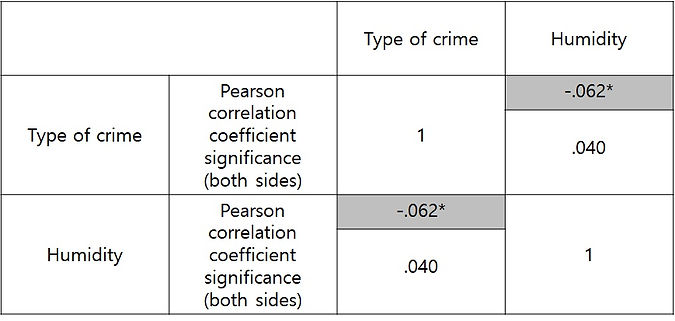Relation with Crime
Weather refers to a general weather condition that appears at any time and is expressed by the elements of temperature, humidity, atmospheric pressure, wind direction, wind speed, and precipitation. As mentioned in the introduction, the weather has been shown to affect human psychology. How will it affect the field of crime where psychology has the greatest impact? To find out about this, let's look at the research of Adolphe Quetelet, who is called the father of modern statistics. He is a Belgian scientist, and among his several papers, Research on the propensity for crime at different ages contains a section on the effect of seasons on criminal propensity. According to Quetelet, based on data on property and violent crime in France, violent crime peaks in the summer (Quetelet, 1911). According to the data released by the London Police Department, BBC Korea reports that when the temperature exceeds 20 degrees, the crime increases by 14% compared to when the temperature is 10 degrees. In the case of sexual harassment, it is said that the increase was 16%. It is said that the crime rate rises as the temperature rises, not only in the UK but also in other countries. Moreover, in Mexico, it can be seen that the crime rate increases by 1.3% for every 1-degree increase in temperature, which can be interpreted as the effect of temperature on human psychology (Reality Check Team, 2018). In addition, looking at the changes in the occurrence of the five major violent crimes by the police according to the winter weather in Seoul, the results of analyzing the data for 63 days showed that the number of violent crimes increased as the minimum temperature increased (Lee & Kim, 2010).
To deal with this in more detail, let's analyze the relationship between climate change factors and crime occurrence. Professor Jongmin Kim conducted an experiment to find out how the five major crimes—murder, robbery, rape, theft, and violence—are related to climate change factors (Kim, Lee, Kim, & Yoo, 2012). They put temperature, precipitation, humidity, and wind speed into the weather change factors and began to find the relationship with crime. The table below is a table that summarizes the average value and standard deviation of the status of each weather element.
As a result of a study based on this data, it was found that there was a significant relationship between temperature and humidity under the significance level of 0.05. The table below shows the correlation between temperature and humidity and crime.

<Graph 1: Relation with Temperature>

<Graph 2: Relation with Humidity>

<Graph 3: Estimated marginal mean of crime type>
In addition, it is said that as summer approaches, the frequency of contact or friction with others increases due to the increase in outdoor activities, which increases the incidence of crimes against people. When the unpleasantness index is added to that, the number of incidental crimes and assaults also increases. This can be interpreted in the direction that sudden climate change or weather is affecting not only our daily life but also crime. Although it is said that crime is greatly influenced by weather and natural environment, weather alone cannot examine the cause of crime.
However, as we have seen before, various crimes that are greatly affected by the climate, crimes are problems caused by relationships between people, ranging from simple violence to violent crimes. Therefore, People should be required to have a caring heart for reducing such a severe crime.